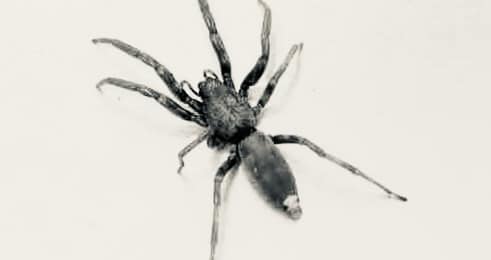When the term “white or white-tailed spider bite” is mentioned, many immediately think of chilling tales and fearsome myths. The name whitetails spider, or white tail spider bite has gained a notorious reputation over time, partly due to media portrayal and partly due to fear of the white-tailed or whitetails spider bite and bites in general. But what’s the real story behind the whitetail or white-tail spider bite? Let’s dive deep into the life of this enigmatic creature, its bite, and the myths surrounding it.
Meet the White Tailed Spider
Physical Characteristics
The white-tailed spider (Lampona cylindrata and Lampona murina) is native to Australia, with a distinctive feature being the faint white spots on the dark reddish grey colour abdomen and tip at the end of the white tail of its dark reddish-grey colour abdomen only. This faint white tail spot stands out against its dark reddish to grey body, creating the notable “white tail” that gives this spider its name.
Body Shape: Cigar-shaped body
Leg Span: Approximately 1.5 to 3 cm
Colour: Dark reddish to grey colour
Abdomen: Grey dorsal abdomen
There are two common species, Lampona cylindrata and Lampona murina, two common species both having a similar appearance and behavior.
Distribution and Habitat
White-tailed spiders are vagrant hunters that live beneath bark, in leaf litter, and within houses. Often, they construct temporary silk retreats to spin webs, providing them with shelter and a place to lay their egg sacs.
Regions Found:
Queensland
New South Wales
Victoria
South Australia
Tasmania
Western Australia
Understanding the White-Tailed Spider Bite
Bite Characteristics
White-tailed spiders are not aggressive by nature and will only sometimes bite humans in self-defence. Their bites have sparked considerable debate due to the occasional reports of severe ulcerative skin lesions attributed to them.
Initial Symptoms:
Immediate burning sensation
Painful red mark or itchy red mark at the bite site
Mild swelling
Clinical Controversy: Necrotic Ulcers
Over time, the white-tail spider bite other white-tail spider bites, and two-tailed spider bites have been linked to necrotic skin ulcers, leading to their reputation as flesh-eating monsters or flesh-rotting monsters. However, the Medical Journal of Australia has indicated that the evidence connecting these white tails of spiders to causing severe skin ulceration is weak. Most bites from white tail spiders, are relatively harmless and are more comparable to a bee sting.
Controversy Points:
Severe ulcerative skin lesions often misattributed to white-tailed spiders
Most cases involve mild swelling and redness
Medical Advice
If bitten by a white tail spider two whitetail two white tail spider two two-tailed spider, it’s essential to apply an ice-cold pack to the two white tail spider bites the bite and area to reduce swelling and seek medical attention if symptoms worsen.
Immediate Actions:
Apply ice pack
Monitor for severe allergic reactions or worsening symptoms
Seek medical attention if necessary
White-Tailed Spider Myths and Realities
Despite their notoriety, the various white tail spiders and spider bite and white tip two pairs of spiders, are often misunderstood. Unlike other spiders like redback spiders or blackhouse spiders, white tail spiders and white tail spiders bite faint white spots and two-tailed spiders rarely cause severe symptoms.
Reality Check:
White-tailed spiders prefer hunting other spiders like daddy legs spiders rather than attacking humans
Not as dangerous as their reputation suggests
The Truth Behind White-Tailed Spider Bites
Common Symptoms of White-Tailed Spider Bites
Despite the myths that surround the female white-tailed spider, spider bite and spider bite because of them, white-tailed spiders do not usually cause severe ulcerative skin lesions. The symptoms of a full white-tailed spider lampona two-tailed spider bite are generally mild and include:
Initial Burning Sensation: Often likened to a bee sting or mild swelling at the bite site.
Red Mark: The bite area typically shows an itchy red mark or a painful red mark, which fades in a few days.
Mild Swelling: Some people may experience localized swelling at the bite site.
Necrotic Ulcers (Rare): Though rare, necrotic ulcers have occasionally been reported in some cases.
Preferred Prey and Behavior
Hunting Style and Diet
White-tail spiders are vagrant hunters that don’t spin webs to capture prey. Instead, they actively hunt and prefer to feed on other spiders, especially black house spiders, daddy-long-legs spiders, the white tail spider bites the other white tail spider, tip spiders, the white-tail spider, redback spider, the white tail spiders and the other white tail spider, tip spiders and curtain web spiders. This makes them beneficial to have around, as they help control populations of other spiders.
Preferred Prey:
Black house spiders
Daddy long legs spiders
Curtain web spiders
White-Tailed Spider Lampona: Cunning Predators
Lampona cylindrata and Lampona murina are skilled hunters who use temporary silk retreats for shelter. Here are some quick facts about their behaviour:
Temporary Silk Retreats: They construct these shelters to rest and lay egg sacs.
Egg Sacs: Female white-tailed spiders can lay several egg sacs, with each containing dozens of eggs.
Vagrant Hunters: They do not spin webs but actively search for their prey.
Medical Management of White-Tailed Spider Bites
Immediate First Aid
Ice Pack: Applying an ice pack to the bite area can help reduce swelling and pain.
Seek Medical Attention: If the symptoms worsen, or if there is a risk of severe allergic reaction, it’s crucial to seek medical attention.
When to Seek Medical Attention
Immediate medical attention is crucial if you experience:
Severe Pain: Intense, throbbing pain at the bite site.
Systemic Symptoms: Nausea, vomiting, sweating, or muscle pain.
Signs of Necrosis: Skin ulceration or necrotic ulcers developing around the bite site.

White-Tailed Spider Bites in Comparison to Other Spiders
Comparing White-Tailed Spider Bites with Other Spider Bites
While white-tailed spiders have been unjustly feared, other white tail spiders are spider spiders that can indeed cause severe reactions. Understanding how white-tailed spider bites compare with bites from white-tailed spider bites from other spiders like redback spiders and blackhouse spiders can provide the many white tail spider bite bites each bite is valuable context.
Redback Spiders (Latrodectus hasselti)
Description: Black or brownish with a distinctive red stripe on the back.
Habitat: Found in dry, sheltered locations such as outdoor toilets, sheds, and mailboxes.
Bite Symptoms:
Immediate pain at the bite site, often severe.
Sweating, nausea, and muscle pain.
Requires urgent medical attention.
Black House Spiders (Badumna insignis)
Description: Dark, robust spiders with velvety black hair.
Habitat: Often found around window frames, sheds, and garden walls.
Bite Symptoms:
Localized pain and swelling.
In some cases, nausea and sweating.
White Tailed Spiders (Lampona cylindrata and Lampona murina)
Description: Cigar-shaped body with a distinctive white tip at the abdomen.
Habitat: Prefers leaf litter, bark, and hidden indoor locations.
Bite Symptoms:
Immediate burning sensation.
Painful red mark and mild swelling.
Daddy Long Legs Spiders (Pholcus phalangioides)
Description: Long, delicate legs with a small grey body.
Habitat: Common in dark corners of houses and sheds.
Bite Symptoms:
Very mild or asymptomatic due to weak venom.
Medical Research and the Controversy
Studies on White-Tailed Spider Bites
Research published in the Medical Journal of Australia and other scientific publications has tried to clarify the confusion surrounding white-tailed or spider bite bites. Key findings include:
No Evidence of Necrotic Ulcers: Studies found no conclusive evidence linking white-tailed spider bites to necrotic ulcers.
Mild Symptoms Predominate: The majority of bites result in mild symptoms similar to a bee sting.
Debunking the Flesh-Eating Monster Myth
Flesh-Eating Monster Myths: Stories of flesh-eating monsters and flesh-rotting monsters are largely exaggerated.
Secondary Infections: Severe ulcerative skin lesions may be due to secondary infections rather than direct effects of the spider venom.
Practical Advice on Dealing with White-Tailed Spiders
Prevention Tips
Clear Leaf Litter and Bark: Keep your surroundings clear of leaf litter and bark where white-tailed spiders like to hide.
Seal Cracks and Gaps: Prevent entry into the home by sealing gaps in windows and doors.
Check Bedding: Shake out bedding and towels if left in dark places.
White-Tailed Spiders and Their Place in the Ecosystem
Ecological Role of White-Tailed Spiders
Beneficial Hunters
White-tailed spiders are not just another creepy crawly to fear; they are also important hunters within their ecosystem. Their role in keeping the population of other spiders in check benefits the human environment.
Preferred Prey: Black house spiders, daddy long legs spiders, and curtain web spiders.
Vagrant Hunters: White-tailed spiders actively hunt their prey, reducing the population of other spiders that can become nuisances.
Coexisting with White-Tailed Spiders
Given their beneficial role, it is advantageous to tolerate their presence to some extent, provided certain precautions are taken:
Seal Entry Points: Ensure that cracks, windows, and doors are sealed to prevent them from wandering inside.
Avoid Leaf Litter Buildup: Keep gardens and lawns free of excessive leaf litter and bark.
Regular House Cleaning: Regular cleaning will minimize hiding places and reduce encounters with white-tailed spiders.
Medical Case Studies and Research Findings
Medical Journal of Australia Studies
Research from the Medical Journal of Australia has helped debunk myths surrounding white-tailed spider bites.
Study 1: Found no definitive link between white-tailed spider bites and necrotic ulcers.
Study 2: Highlighted the importance of proper wound care to prevent secondary infections.
Comparing White-Tailed Spiders Across Regions
Southern and Western Australia
Common Species: Lampona cylindrata and Lampona murina.
Preferred Habitats: Bark, leaf litter, and under rocks.
Queensland and New South Wales
South East Queensland: High presence in urban areas.
New South Wales: Common in gardens and around homes.
Victoria, South Australia, and Tasmania
Victoria South Australia Tasmania: All have populations of white-tailed spiders, particularly in urban environments.
Handling Encounters and Preventive Measures
Safe Removal of White-Tailed Spiders
Catch and Release: Use a jar and a piece of paper to safely capture the spider and release it outside.
Avoid Direct Contact: Avoid handling spiders directly to minimize the risk of bites.
Reducing Spider Populations Around the House
Declutter: Clear away clutter that could provide hiding spots.
Outdoor Lighting: Reduce outdoor lighting to minimize attracting flying insects that draw spiders.
Check Bedding and Towels: Shake out bedding and towels that have been left in dark corners.
On-Time Service

5 STAR SERVICE BASED ON 100+ GOOGLE REVIEWS
PET & FAMILY FRIENDLY TREATMENT

ALL YEAR-ROUND PROTECTION
Take Back Control Now
8
REASON TO CHOOSE SAFE PEST CONTROL
- Guarantee protection all year-round
- 30 Years Collective Experience
- An impeccable reputation across Sydney's Suburbs
- Certified treatments & written Warranty On all work carried out
- Family Owned & Operated
- Rated #1 Pest Control In Sydney NSW
- No Mess, No Smell
- Family & Pet Friendly Treatments
REQUEST A QUOTE

